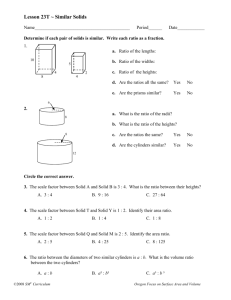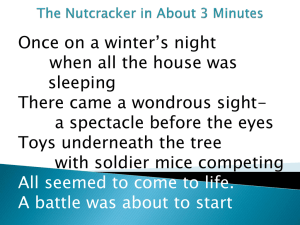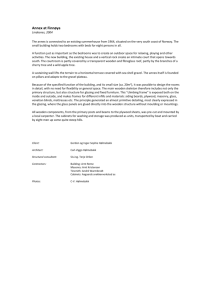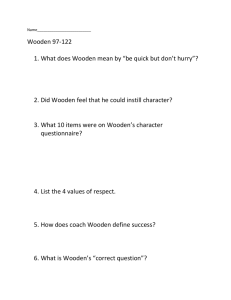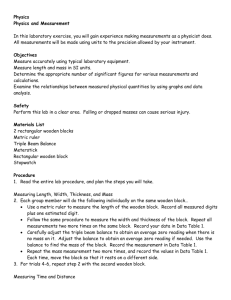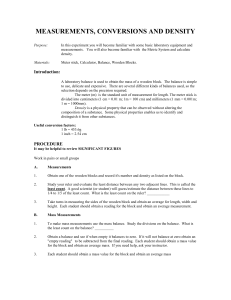PMR-Form2-Maths-Set 3 - E
advertisement
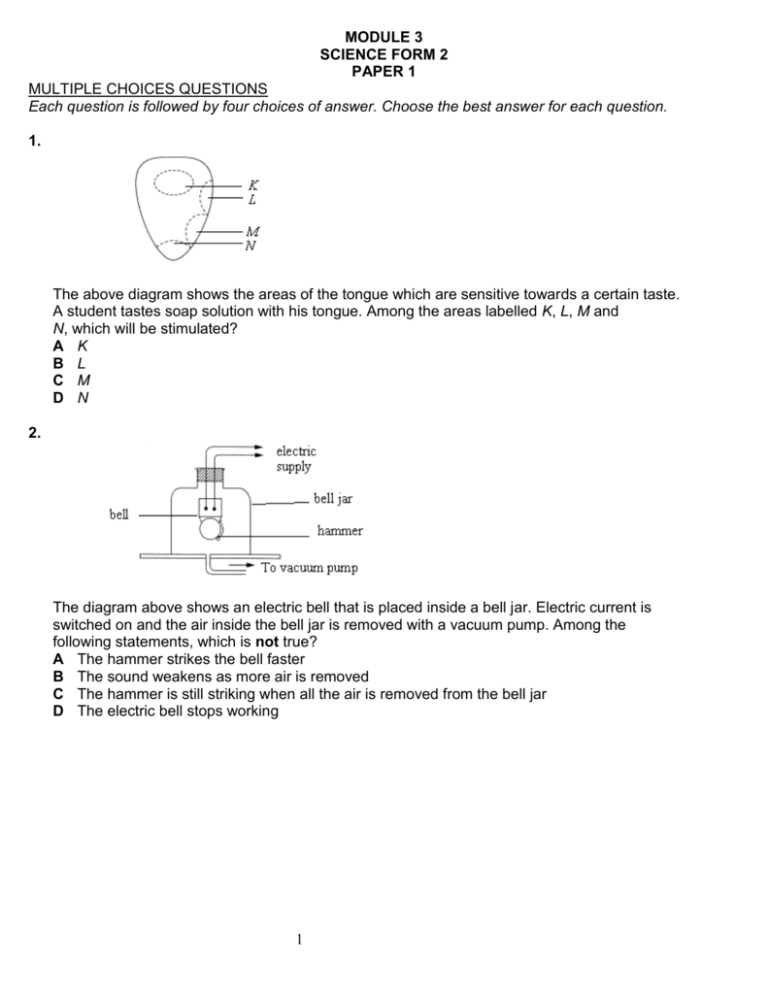
MODULE 3 SCIENCE FORM 2 PAPER 1 MULTIPLE CHOICES QUESTIONS Each question is followed by four choices of answer. Choose the best answer for each question. 1. The above diagram shows the areas of the tongue which are sensitive towards a certain taste. A student tastes soap solution with his tongue. Among the areas labelled K, L, M and N, which will be stimulated? A K B L C M D N 2. The diagram above shows an electric bell that is placed inside a bell jar. Electric current is switched on and the air inside the bell jar is removed with a vacuum pump. Among the following statements, which is not true? A The hammer strikes the bell faster B The sound weakens as more air is removed C The hammer is still striking when all the air is removed from the bell jar D The electric bell stops working 1 3. The diagram above shows the set-up for an experiment. What is the conclusion that can be made regarding this experiment? A Roots responds more to geotropism than hydrotropism B Roots responds more to phototropism than geotropism C Roots responds more to hydrotropism than phototropism D Roots responds more to hydrotropism than geotropism 4. There is a class of food that consists of carbon, hydrogen, oxygen and nitrogen. Among the following, which is the function of the class of food mentioned, to human beings? A Main energy source B Substance for building new cells C Dissolves a certain vitamins in the body D Protects the body against diseases 5. The pH value in the stomach is measured based on the time and the result is plotted as shown in the diagram above. Among the following, what happens in stage Y? A Stomach stops secreting gastric juice B Peristalsis takes place C Digestion of food takes place D Water is absorbed from food 2 6. A student wanted to test whether he was having diabetes or not. So he heated up some sample of his urine in solution X. Solution X could possibly be I Benedict's solution II Fehling's solution III Millon's reagent A I only B I and II only C II and III only D I, II, and III 7. Which of the following is true regarding the list of animals shown below? A B C D centipede prawn moth Does not have a backbone Breathes through lungs Lives in water Supported by body fluids 8. The diagram below shows a graph of teh body temperature of a vertebrate against the temperature of its surroundings. Which of the following is the animal? I Bat II Platypus III Crocodile A I and II only B I and III only C II and III only D I, II and III 3 9. Based on the plants listed above, their common characteristics are as follows: I have chlorophyll II grow in the water III does not produce flower A I only B I and II only C II and III only D I, II, and III 10. A type of wood lice live in a tree trunk. When the contents of the alimentary canal of the wood lice were analysed, it was found that it had fluid from the tree. Gradually the tree wilted. The wood lice can be classified as a A predator B host C symbiont D parasite 11. The tapeworm adapts itself in the intestine of animals by I anchoring itself to the host with hooks II producing mucus to protect itself from the action of digestive enzymes III absorbing nutrients from its host A I only B I and II only C II and III only D I, II, and III 12. Examples of biological control include the use of I fish to control the population of mosquito larva in a pond II owls to control the population of rats in oil palm plantation III birds to control the population of the grasshoppers in a fruit orchard A I only B I and II only C II and III only D I, II, and III 4 13. Solution X shows the characteristics below: Among the following, which is X? A Limewater B Sauce C Vinegar D Distilled water 14. A certain acid is electrolysed using platinum electrodes as the anode and cathode. What are the pH values of the gases formed in the anode and cathode? Anode Cathode A pH 3 pH 11 B pH 6 pH 8 C pH 7 pH 7 D pH 8 pH 10 15. The above diagram shows the process of electrolysis of water. What is the characteristic of gas X collected in the test tube? A Produces a 'pop' sound when tested with a lighted wooden splint B Helps in burning C Acidic in nature D Has a pungent smell 5 16. The diagram above shows a certain process of water purification. A student who drinks the clear water produced through that filtration process is later found having stomachache. Among the following, which explains the reason for that incident? A The clear water does not contain dissolved salt B There is still micro-organism in that clear water C There are still filthy substances in between the gaps of gravel and stone D River water has a lot of filthy substances 17. A type of gas is collected at the negative electrode during an electrolysis involving dilute hydrochloric acid and platinum electrodes. Among the following, which is the characteristic of that gas? I Does not help in combustion II Less dense than air III Does not dissolve in water A I only B I and II only C II and III only D I, II, and III 18. The following are the reasons causing the tin to become dented when it is heated until all the air is driven out and the cap tightly closed before cold water is poured over it except A cold water condenses the steam into water B air pressure outside the tin which is higher pushes the tin inwards C air pressure inside the tin decreases D air pressure inside the tin increases 6 19. In the diagram above, the spring extends 5 cm when a 400 N load is being hooked on it. What is the extension when a 100 N load is hung on X if both the springs are the same? A 1.00 cm B 1.25 cm C 1.50 cm D 1.75 cm 20. The string tying the balloon in the diagram above is untied and the balloon released. Among the following, which shows the type of force and observation that takes place when the balloon is released? Type of force Observation A Electrostatic Turn in a circular motion B Frictional Produce a loud sound C Pull Stay in a static position D Push Move fast in the opposite direction of the hand 21. Ali carries a 20 kg sack of rice to a height of 30 m in ½ minute. If the weight of Ali is 500 N, how much power does he generate? A 170 W B 200 W C 520 W D 700 W 7 22. Force is used when I a toy car changes the direction of its motion II a toy car slows down its motion III a stationary toy car moves A I only B I and II only C II and III only D I, II, and III 23. Among the following, which influences the movement of a wooden block that is pushed on the floor? I The contact of surface between the block and the floor II The weight of the block III The surface area that is in contact A I only B I and II only C II and III only D I, II, and III 24. The diagram above shows the support system on vertebrates and invertebrates. Among the following, which represents the support system for X, Y and Z? X Y Z A Buoyancy of water Hydrostatic skeleton Endoskeleton B Hydrostatic skeleton Endoskeleton Turgidity of cell C Endoskeleton Buoyancy of water Hydrostatic skeleton D Hydrostatic skeleton Turgidity of cell Buoyancy of water 25. Plants that float on the water surface usually have the following structures except that they have A big air sacs inside their stems B stomata on the top surface of their leaves C roots that are long and strong D light and soft tissues 8 26. How is a seedling able to stand upright? A it is supported by a strong stem B it is supported by its long roots C it is supported by the turgidity of its cells D It is because it has few leaves 27. The body of a vertebrate cannot be supported by I exoskeleton II hydrostatic skeleton III buoyancy of water A I only B I and II only C II and III only D I, II, and III 28. The diagram above shows four wooden blocks, K, L, M and N. Those four blocks are put side by side on top of a plank. If the plank was tilted slowly, which wooden block will topple last? A K B L C M D N 29. A double-decker bus will be more stable if it I does not allow passengers to put heavy things at the lower deck II does not allow passengers to stand at the upper deck III fill the lower deck with passengers first A I only B I and II only C II and III only D I, II, and III 9 30. Among the following, which needs an effort of 20 N so that the rod becomes balanced? A B C D I only I and II only II and III only I, II, and III 10 ANSWER MODULE 3 SCIENCE FORM 2 PAPER 1 1. A 2. D 3. D 4. B 5. C 6. B 7. A 8. A 9. A 10. D 11. D 12. B 13. D 14. C 15. A 16. B 17. D 18. D 19. B 20. D 21. D 22. D 23. B 24. C 25. C 26. C 27. B 28. D 29. C 30. D 11 MODULE 3 SCIENCE FORM 2 PAPER 2 STRUCTURED QUESTION 1. Four sets of similar apparatus, as shown in the figure above were used in an experiment. The following steps were used to carry out the experiment. S1 The water bath for each set of apparatus was kept at these temperatures respectively: 24° C, 30° C, 36° C and 42° C. S2 After 5 minutes, the contents of each tube was analysed to find out how much sugar was present. S3 The results of the experiment was recorded in the table below. (a) State the variables in the experiment. Types of variables Variable that is kept constant Manipulated variable Responding variable Factor (i) (ii) (iii) (b) Which temperature is most suitable for the formation of sugar? _______________________________________________________________ (c) Suggest the reason for your answer in (b). _______________________________________________________________ _______________________________________________________________ 12 (d) Draw a graph to show the amount of sugar produced versus temperature. (e) An enzyme is needed to change starch to sugar. What have you learnt about this enzyme, based on the results of this experiment? _______________________________________________________________ (f) Name the enzyme present in saliva. _______________________________________________________________ (g) Predict what would happen if : (i) a little acid was added to the test tube kept at 36°C. ___________________________________________________________ ___________________________________________________________ (ii) a little alkali was added to the test tube kept at 36°C. ___________________________________________________________ ___________________________________________________________ 13 2. An experiment is set up as shown above. The following steps were carried out. S1 One wooden block is attached to a spring balance. S2 It is pulled across the table S3 The reading on the spring balance is noted just as the wooden block begins to move. S4 The experiment is repeated using two wooden blocks. (a) Suggest a hypothesis for this experiment. _______________________________________________________________ (b) State the variables in this experiment. (c) (d) Predict the reading on the spring balance if three wooden blocks are used. _______________________________________________________________ 14 (e) Sketch a graph to show the relationship between the weight of an object and the magnitude of friction produced. (f) Suggest another factor, other than weight, that increases friction. _______________________________________________________________ 15 3. An experiment was set up as shown above. The following steps were carried out: S1 Two similar measuring cylinders were placed on a table. One was correct side up. The other was upside down. S2 The similar toy cars were wound up and placed 40 cm away from the measuring cylinders. S3 The toy cars were released and they moved towards the measuring cylinders. (a) State 'falls down' or 'stays upright' to show the result of the experiment. (b) State the variables in the experiment. (c) What is the aim of this experiment? _______________________________________________________________ (d) What are the three factors that affect the stability of an object? (i) ___________________________________________________________ (ii) ___________________________________________________________ (iii) ___________________________________________________________ (e) Why is the concept of stability important in the design of objects and buildings? _______________________________________________________________ 16 ANSWER MODULE 3 SCIENCE FORM 2 PAPER 2 STRUCTURED QUESTION 1. (a) (i) The amount of starch/Volume of saliva (ii) Temperature of the water bath (iii) Amount of sugar (b) 36°C (c) The enzyme in saliva that converts starch to sugar, works best at this temperature. 36°C is similar to the body temperature. (d) (e) The enzyme works best at around 36°C, which is almost the same as the body temperature. It does not work well at lower (24°C) or higher (42°C) temperatures. (f) Amylase (g) (i) Less sugar would be formed (ii) More sugar would be formed 2. (a) Friction between two surfaces in contact increases when the weight of the object increases. (b) (i) The surface on which the wooden block is placed (ii) The type of material (wood) of the object (block) (iii) The point when the reading of the spring balance is taken (iv) The weight of the object (block) (v) The reading of the spring balance (c) 3 N (d) 9 N (e) (f) The roughness of a surface affects friction. The rougher the surface, the greater the friction. 17 3. (a) (i) Falls down (ii) Stays upright (b) (i) The type of measuring cylinders (ii) The distance between the toy cars and the measuring cylinders (iii) The positions of the measuring cylinders (whether correct side up or upside down) (iv) Whether the measuring cylinder falls down or stays upright (c) To determine if a heavier base area makes an object more stable. (d) (i) the position of the centre of gravity (ii) the weight of the object (iii) the base area of the object (e) To prevent objects and buildings from collapsing and causing property damage and loss of lives. 18
